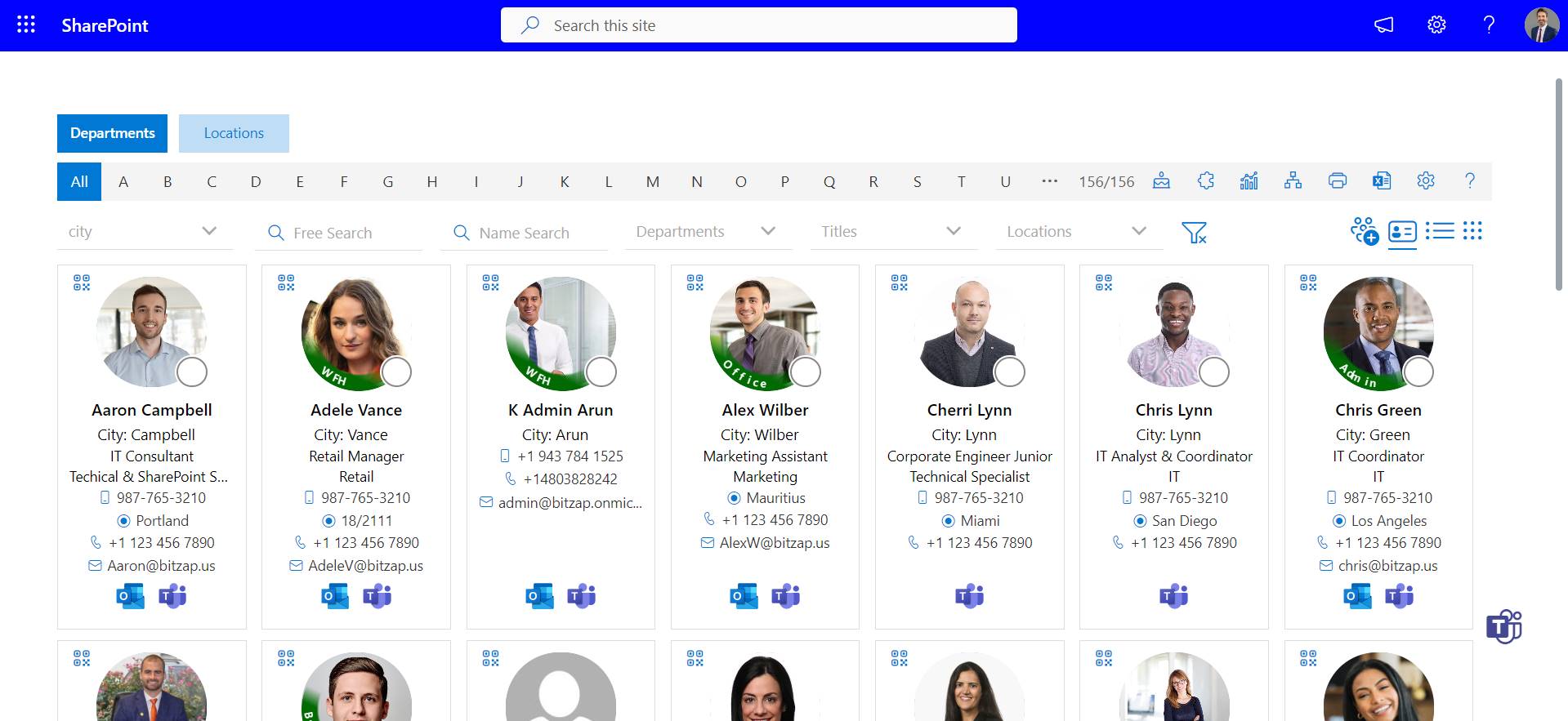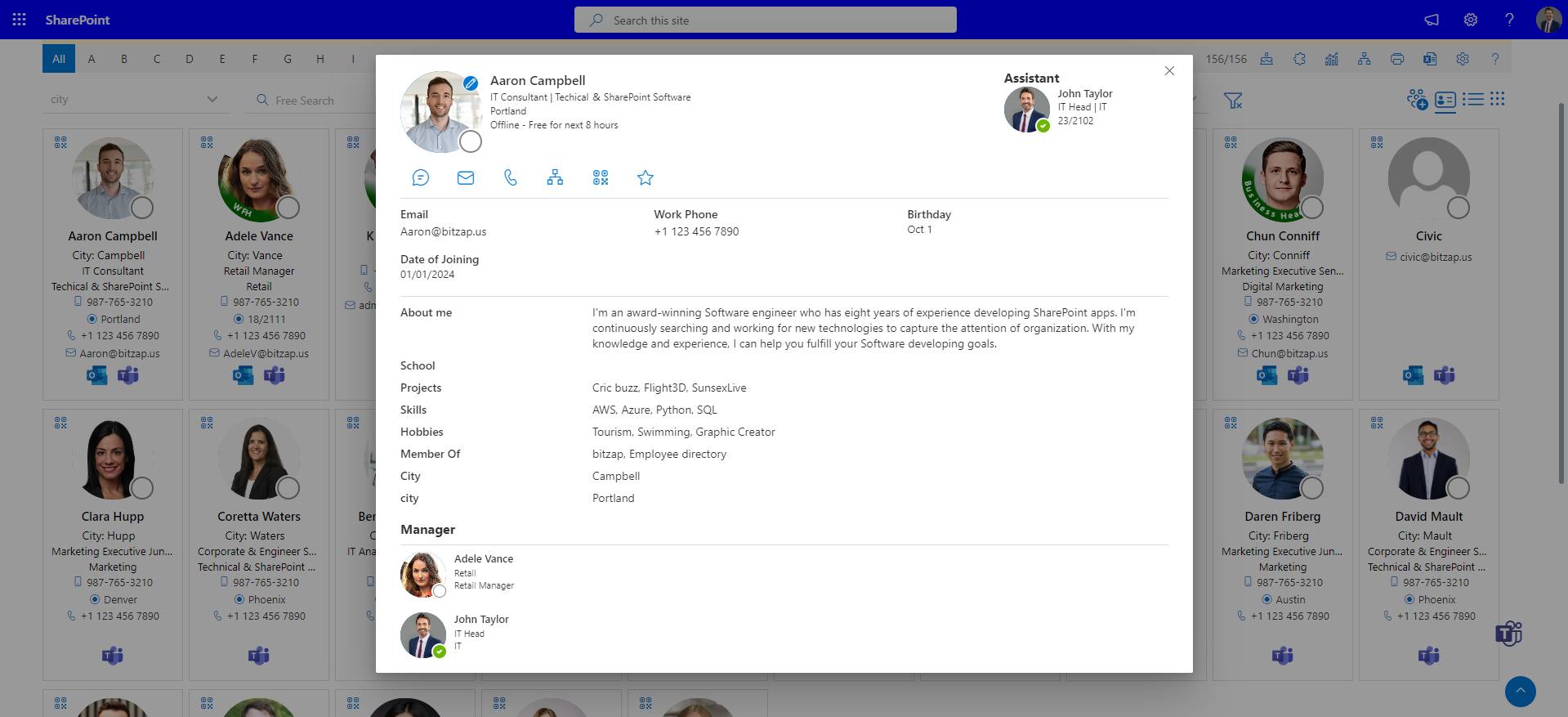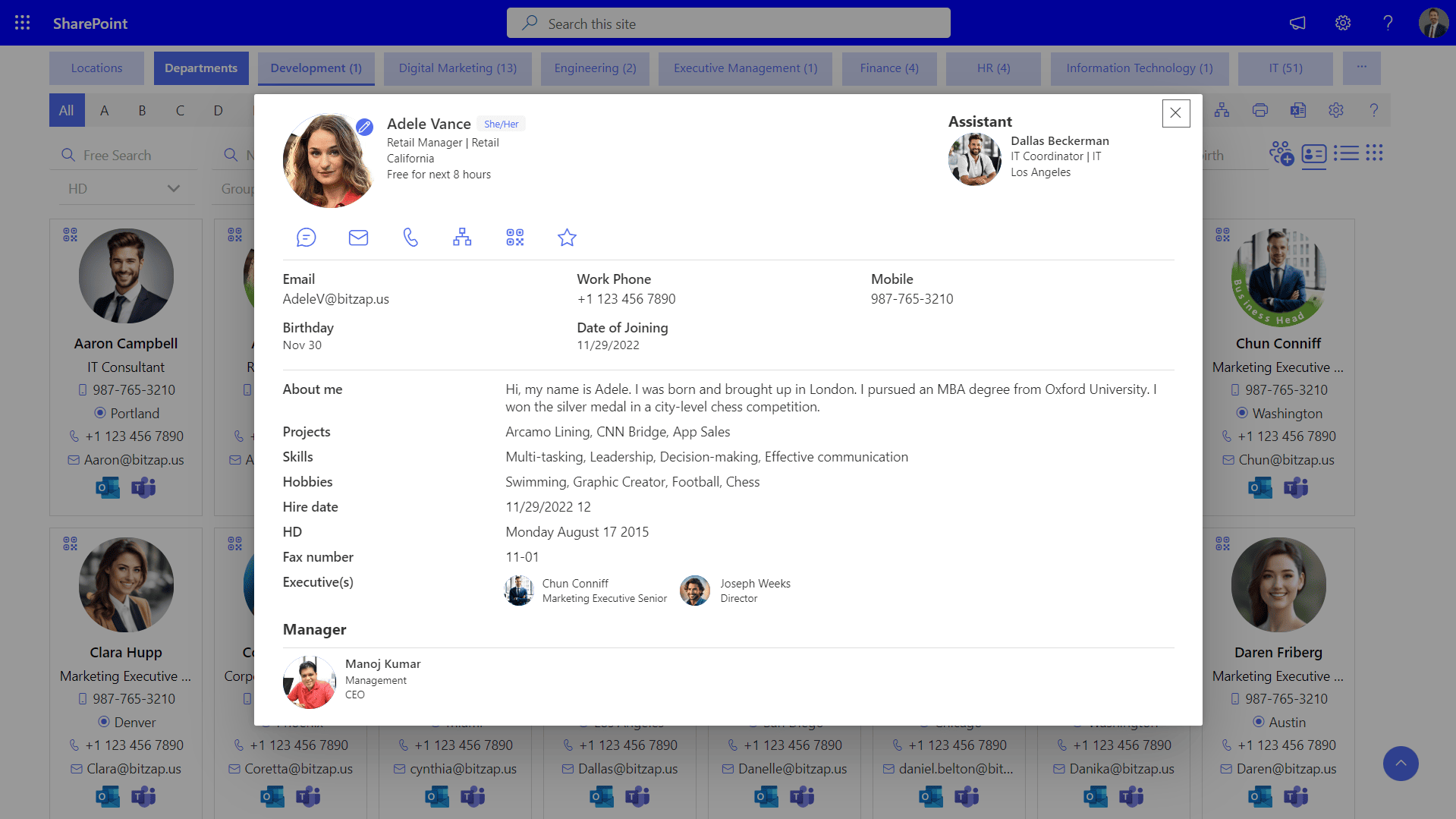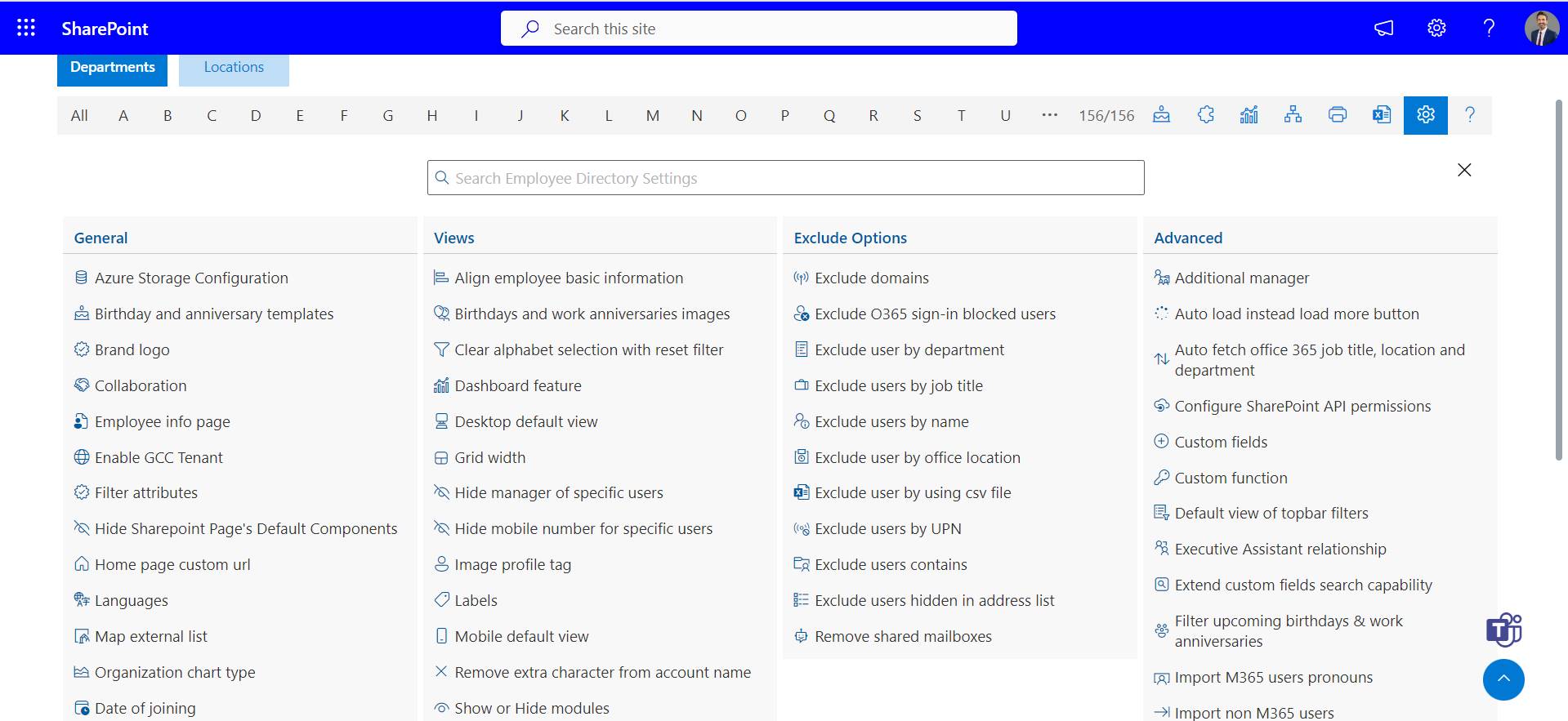Employee Directory
Discover your colleagues instantly with Employee Directory. Effortlessly find, contact, and collaborate with team members across all departments.
Employee Directory
Discover your colleagues at a glance with Employee Directory, your gateway to knowing and connecting with everyone in organization. Effortlessly find, contact, and collaborate with team members across all departments.
What is an Employee Directory?
An Employee Directory is a centralized and organized list of employees within an organization, often containing various pieces of information about everyone.
The directory is designed to facilitate communication, improve collaboration, and provide easy access to relevant employee details.
What does an Employee Directory do?
An Employee Directory serves several key functions within an organization, aimed at improving communication, enhancing collaboration, and streamlining various administrative tasks. Here are the main functions and benefits of an Employee Directory:
1.Facilitates Communication:
Provides easy access to contact information, such as email addresses and phone numbers, making it simple for employees to connect with each other Includes details about employees’ roles, departments, and reporting structures, helping staff know whom to reach out to for specific queries or issues.
2. Enhances Collaboration:
Allows employees to find colleagues with specific skills or expertise, fostering collaboration on projects and tasks. Helps new employees quickly identify and connect with team members, accelerating the onboarding process.
3. Improves Organizational Transparency:
Offers a clear view of the organizational structure, showing how different departments and teams are interconnected. Provides visibility into who holds which positions and their responsibilities, aiding in understanding company hierarchy and workflow.
4.Streamlines Administrative Processes:
Centralizes employee information, reducing the need for multiple, disparate sources of information. Simplifies the process of updating employee details, ensuring that information is always accurate and up-to-date.
5. Supports HR Functions:
Assists in workforce planning and management by providing an overview of employee distribution across departments and locations. Helps HR professionals track and manage employee information, performance records, and other pertinent data.
6. Enhances Employee Engagement:
Includes personal information such as hobbies and interests, which can foster a sense of community and belonging among employees. Encourages employees to update their profiles, promoting a more connected and engaged workforce.
7.Integration with Other Tools:
Often integrates with other internal tools like calendar systems, messaging platforms, and project management software, providing a seamless experience for users. Can be linked with HR software for better management of employee data and workflows.
8. Accessibility:
Makes employee information accessible to authorized personnel from anywhere, especially important for organizations with remote or distributed teams. Provides search and filter functionalities to quickly find specific employees or groups based on various criteria.
An Employee Directory is a vital tool for fostering communication, collaboration, and efficiency within an organization, contributing to a more connected and productive workplace.
What are the features of Employee Directory?
An Employee Directory typically includes a range of features designed to facilitate communication, enhance collaboration, and improve organizational efficiency. Here are some common features of an Employee Directory:
Search Functionality
- Search functionality is a fundamental feature of an employee directory, offering users a quick and efficient way to find specific individuals within an organization.
- This feature allows users to enter search queries, such as a person’s name, job title, department, or other relevant criteria, and receive instant results that match their search terms.
- By leveraging this functionality, employees can easily locate colleagues they need to communicate or collaborate with, regardless of the organization’s size or complexity.
- Whether it’s identifying a department head, finding a subject matter expert, or locating a team member for a project, the search feature streamlines the process, saving time and enhancing productivity.
Employee Profiles
- Employee profiles are a cornerstone of an employee directory, offering comprehensive snapshots of each individual within an organization.
- These profiles typically include vital details such as contact information, job title, department, and reporting structure, providing colleagues with essential context for effective communication and collaboration.
- By centralizing this information in easily accessible profiles, the employee directory fosters transparency and connectivity across the organization, empowering employees to connect with the right people efficiently.
Contact Information
- The contact information feature of an employee directory serves as a vital resource for facilitating communication and connectivity within an organization.
- By providing readily accessible email addresses, phone numbers, office locations, and other contact details for each employee, the directory streamlines the process of reaching out to colleagues for collaboration, inquiries, or assistance.
- Whether employees need to coordinate on a project, seek guidance from a supervisor, or simply touch base with a coworker, having contact information readily available fosters seamless communication and enhances productivity.
Organization Chart
- The organization chart feature provides a visual representation of the hierarchical structure and reporting relationships within an organization.
- This feature offers employees a clear understanding of the organizational hierarchy, illustrating how different departments, teams, and individuals are interconnected.
- By displaying reporting lines and managerial roles, the organization chart helps employees identify key decision-makers, understand the chain of command, and navigate the organizational structure more effectively.
Security and Privacy
- Security and privacy features are paramount for safeguarding sensitive information and ensuring compliance with data protection regulations.
- These features encompass various measures to protect employee data from unauthorized access, misuse, or breaches.
- This may include user authentication mechanisms such as login credentials, multi-factor authentication, or single sign-on to verify the identity of users accessing the directory.
- Additionally, access controls and permission settings are implemented to restrict access to specific employee information based on roles or responsibilities within the organization.
Advanced Search Filters
- The advanced search filters feature enhances the efficiency and precision of locating specific individuals or groups within an organization.
- This feature empowers users to refine their search queries by applying various criteria or filters beyond basic keyword searches. Users can narrow down search results based on parameters such as department, job title, location, skills, or even specific project involvement.
- The flexibility and customization afforded by this feature accommodate diverse user needs and preferences, ensuring that individuals can personalize their search queries to align with their specific requirements.
Analytics and Reporting
- The analytics and reporting feature provides valuable insights into how the directory is utilized and helps organizations optimize its effectiveness.
- Through analytics, administrators can track key metrics such as the number of searches performed, most frequently viewed employee profiles, popular search queries, and trends in directory usage over time.
- These insights enable organizations to identify patterns, understand user behavior, and make data-driven decisions to improve the directory’s usability and relevance.
- Reporting capabilities allow administrators to generate comprehensive reports on directory activity, which can be used for performancse evaluation, compliance audits, or strategic planning purposes.
These features collectively help create a comprehensive and user-friendly Employee Directory that supports effective communication, collaboration, and management within an organization.
What are the benefits of using employee directory software?
Using employee directory software provides numerous benefits to an organization, ranging from improved communication to enhanced efficiency.
Here are some key benefits:
Enhanced Communication:
- Centralized Contact Information: Provides easy access to up-to-date contact details, facilitating quick and efficient communication between employees.
- Clear Reporting Structures: Helps employees understand the organization’s hierarchy, making it easier to know whom to contact for specific issues.
Improved Collaboration:
- Skill and Expertise Search: Allows employees to find colleagues with specific skills and expertise, promoting better collaboration on projects and initiatives.
- Team Awareness: Helps team members become aware of who is part of their team and what their roles are, fostering better teamwork.
Increased Efficiency:
- Quick Information Access: Reduces time spent searching for contact details and other employee information, increasing overall productivity.
- Self-Service Updates: Enables employees to update their own information, reducing the administrative burden on HR and ensuring data accuracy.
Better Onboarding:
- Introduction to Colleagues: New hires can quickly learn about their colleagues and understand the organizational structure, aiding in smoother integration.
- Resource Availability: Provides new employees with easy access to contact details and department information, helping them find the right resources quickly.
Organizational Transparency:
- Visibility of Roles and Responsibilities: Offers a clear view of who holds what position and their responsibilities, promoting transparency.
- Organizational Charts: Visual representations of the company’s structure help employees understand reporting lines and departmental relationships.
Employee Engagement:
- Recognition and Profiles: Allows for personal touches like profile pictures, hobbies, and interests, which can enhance employee engagement and foster a sense of community.
- Employee Highlights: Features for recognizing achievements and milestones can boost morale and engagement.
Integration with Other Systems:
- Calendar and Messaging Integration: Syncs with calendar systems and messaging platforms, making it easy to schedule meetings and communicate directly from the directory.
- HR and Payroll Systems: Integration with HR and payroll systems ensures consistent and accurate employee data across platforms.
Access Control and Security:
- Role-Based Access: Ensures that sensitive information is only accessible to authorized personnel, enhancing data security.
- Privacy Settings: Allows employees to control the visibility of their personal information, respecting privacy preferences.
Scalability and Flexibility:
- Custom Fields and Configurations: The ability to add custom fields and configurations means the software can grow and adapt to the organization’s changing needs.
- Mobile Access: Mobile-friendly designs or dedicated apps ensure that employees can access the directory from anywhere, improving flexibility.
Analytics and Reporting:
- Workforce Insights: Provides analytics and reporting tools that offer insights into workforce demographics, helping in strategic decision-making.
- Usage Metrics: Tracks how the directory is used, providing valuable data for improving internal processes and communication strategies.
Employee directory software is a powerful tool that supports efficient management, enhances employee interactions, and fosters a more connected and productive work environment.
How to choose the best employee directory software?
Choosing the best employee directory software involves evaluating various factors to ensure it meets your organization’s needs. Here are the key considerations to guide you in selecting the most suitable employee directory software:
1.Identify Your Needs:
- Features Required: Determine the essential features you need, such as contact management, organizational charts, search functionality, integration capabilities, mobile access, and customization options.
- Scale and Scope: Consider the size of your organization and the scope of use. Ensure the software can scale with your organization’s growth.
2. User-Friendly Interface:
- Ease of Use: Choose software with an intuitive and user-friendly interface to ensure that employees at all levels can easily navigate and use the directory.
- Employee Self-Service: Look for self-service features that allow employees to update their profiles, reducing the administrative burden on HR.
3. Integration Capabilities:
- Existing Systems: Ensure the software can integrate seamlessly with your existing systems, such as HR software, payroll systems, communication tools (e.g., Slack, Microsoft Teams), and calendar applications.
- Future Integration: Consider the potential need for future integrations with other tools or platforms you may adopt.
4. Customization and Flexibility:
- Custom Fields: The ability to add custom fields and configure the directory to meet specific organizational needs is crucial.
- Branding: Look for options to customize the interface to align with your company’s branding and culture.
5. Accessibility:
- Mobile Access: Ensure the software is mobile-friendly or offers a dedicated mobile app for on-the-go access.
- Role-Based Access: Check for features that allow role-based access control to ensure appropriate data privacy and security.
6. Security and Compliance:
Data Security: Ensure the software provides robust security features, such as encryption, secure user authentication, and data access controls.
Compliance: Verify that the software complies with relevant data protection regulations (e.g., GDPR, HIPAA) to ensure legal compliance.
7. Support and Training:
Customer Support: Assess the availability and quality of customer support, including response times and support channels (e.g., email, phone, chat).
Training Resources: Look for comprehensive training materials, such as tutorials, user guides, and webinars, to help employees and administrators get the most out of the software.
By carefully evaluating these factors, you can choose the best employee directory software that aligns with your organization’s needs and goals, enhancing communication, collaboration, and overall efficiency.
Conclusion
An employee directory is an indispensable tool for modern organizations, enhancing communication, collaboration, and overall efficiency. By centralizing vital employee information such as contact details, job titles, and departmental affiliations, it provides a clear and accessible resource for all members of the organization. Ultimately, a well-maintained employee directory fosters a culture of transparency, accountability, and collaboration. It empowers employees to connect, share knowledge, and work together more effectively, driving the organization towards its goals.
Frequently Asked Questions
Yes, many employee directory software solutions allow customization to include additional fields, align with company branding, and meet specific organizational needs.
The frequency of updates depends on the system and organizational practices. Many modern employee directories offer real-time updates or allow employees to update their own information, ensuring data accuracy and currency.
Yes, Microsoft offers several solutions that can be used to create and manage an employee directory, particularly within organizations that use Microsoft 365 (formerly Office 365) or Azure Active Directory (Azure AD). Here are some options:
- Microsoft Teams:
- Microsoft Teams, a collaboration platform, includes a feature called the “Organization” tab, which provides a basic employee directory within the Teams interface.
- Users can search for colleagues, view their profiles, and initiate chats or calls directly from the directory.
- SharePoint:
- SharePoint, Microsoft’s document management and collaboration platform, can be customized to include an employee directory.
- Organizations can create employee profile pages using SharePoint’s built-in features or by integrating with Microsoft Graph API to pull employee data from Azure AD.
- Delve:
- Delve is a Microsoft 365 application that helps users discover and organize content across Microsoft 365 services.
- While Delve primarily focuses on content discovery, it also includes a profile directory where users can view basic information about their colleagues.
While Microsoft provides these tools and platforms for creating and managing employee directories, the specific implementation and features may vary depending on the organization’s requirements and the Microsoft 365 subscription plan or licensing agreements in place.
Schedule a free personalized 1:1 demo
By proceeding, you accept Cubic Logics’s terms and conditions and privacy policy






Start Your Free Experience
By proceeding, you accept Cubic Logics’s terms and conditions and privacy policy






Schedule a free personalized 1:1 demo
By proceeding, you accept Cubic Logics’s terms and conditions and privacy policy






Try It Free, No Obligation
By proceeding, you accept Cubic Logics’s terms and conditions and privacy policy






Request of the Free License
By proceeding, you accept Cubic Logics Terms and Conditions and Privacy Policy
Offer is expiring soon!
Fill in your details below to receive your personalized coupon code.
Start Your Free Experience
By proceeding, you accept Cubic Logics’s terms and conditions and privacy policy












